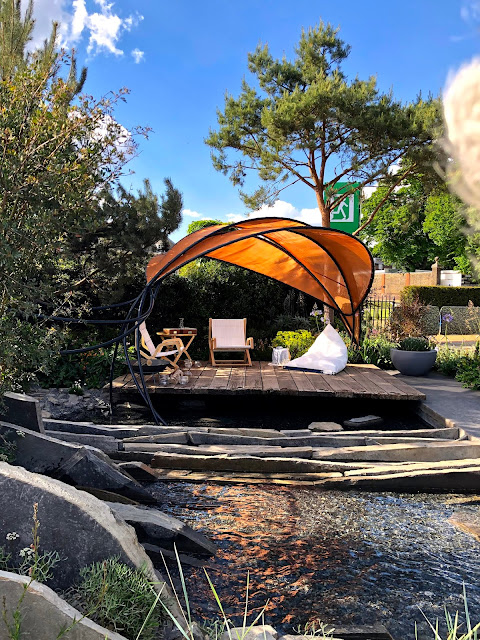 |
| The summerhouse catches the eye from the shade of the orchard |
Gardens are constantly evolving, even if the gardener does nothing more than cut the grass, but most gardeners make small incremental changes - which they hope will be improvements - each year. It's surprising how long it takes for new ideas to take root. Gardening is a slow process, and one can sometimes wake up with an idea fully formed, while others take years to come to the surface. Winter is usually the time when new ideas germinate, which then take root in spring as the light reinvigorates our imaginations.
The most obvious change that has been made to the garden at Old Swan House in 2019 is the painting of the summerhouse. It took a long time and many trial pots of paint to settle on the colour and even now it will probably be finished off with varnish sometime next year.
 |
| The summerhouse in its new livery - May 2019. It may get a varnish next year. |
Another change is the result of the old dead cherry tree beside the summerhouse coming down in a storm. It had been completely covered by honeysuckle (Halliana) and its windage became too great. It has been replaced with an iron obelisk which the honeysuckle (after being cut back to the ground) is now scrambling up and which will again provide much-needed shade as well as scent when sitting outside the summerhouse.
 |
| The two new large box balls next to the summerhouse and the 'Halliana' honeysuckle scrambling to the top of the new obelisk |
More box balls have been added to the already crowded field in the shape of two large ones placed in terracotta urns either side of the summerhouse. These 'anchor' it and already look as if they have always been there.
 |
| The two new urns and their box balls on 'Venky's Terrace' |
'Venky's Terrace' in the orchard has also had two large urns and box balls added to make it more of a room. The urns are of the beautiful pressed brick which unfortunately will no longer be available. A Trachelospermum has been planted on the apple tree and trained up
it. The terrace is now much better shaded than last year.
 |
The black bamboo behind the cut down hebe.
|
Less successful has been the chopping down of the hebe next to the wildflower area. It had become very leggy and overgrown but by flopping in front of the wildflowers, it provided a necessary air of mystery, which is now lacking. To counteract this, a black bamboo has been planted, but it will be some time before that is large enough to provide a barrier.
Another black bamboo has been planted beside the summerhouse, that one day will throw its plumes over the roof
 |
| The black bamboo next to the summerhouse (it's almost invisible) |
 |
| The granite horse - 'Khan' - has been given boxes of alchemilla to froth at this feet |
Finally, at the other end of the garden, more box balls have been added to the pond area - one in the middle and another on the plinth at the side. I had hoped to put a small statue on the plinth to match the horse's head, but haven't yet found a suitable one.
 |
| The box walk and the armillary sphere are well settled in |
 |
The line-up of box by the pond is now complete
|
Needless to say, there are more plans afoot, but nothing further is likely to be done this year.







